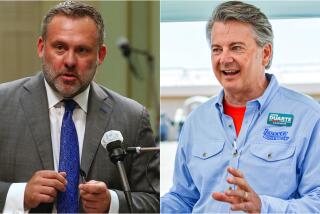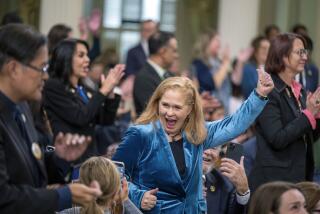Democrats Hearing Footsteps in Race to Get Voters on Rolls
On election night last November, the Democrats in the San Fernando Valley had reason to sip champagne. Every Valley Democratic incumbent in the Legislature and in Congress was returned to office. Almost all of them annihilated their opponents at the polls.
Yet, with the election results barely cold, the staffs of the Valley Democratic leadership began meeting privately to discuss the need for a voter-registration drive. Waging such an early drive, almost two years before the next major election, would be unprecedented.
A set of numbers that received scant attention during the election campaign explains why some of the Democrats are worried.
Republican Infiltration
Voter registration figures show the Republicans did a great job of infiltrating traditionally Democratic territory in the Valley. The GOP posted big gains in registration in every Assembly, senatorial and congressional district here last year. In the five Valley Assembly districts, the Republicans in Los Angeles and Ventura counties registered 60,693 people in the 10 months before the general election. The Democrats registered 36,219. The GOP gains were despite a Democratic registration drive that was better organized than most.
âThey caught everybody sleeping,â observed one Democratic political aide in the Valley who asked to remain anonymous.
All the Valley Democrats, even Sen. Alan Robbins of Van Nuys, who was not up for reelection last year, saw the percentages of Democratic voters shrink two or three points in their respective districts, except the district of Assemblyman Gray Davis of Sherman Oaks, which lost 1%. At the same time, the Republican registration inched up by the same amount.
Nearing âMagic Numberâ
The Republicans did not accomplish the impossible: The Democratic elected officials still preside over Democratic districts. What the Republicans did do was close in on their âmagic number.â As a rule of thumb, political experts say 35% of the voters must be Republicans if a GOP candidate expects to have a realistic chance of winning. This number is much lower than the Democratsâ âmagic numberâ--at least 54%--because Republicans tend to vote more loyally than Democrats.
Thanks to their aggressive voter registration drive, Republicans now account for 34% of the registered voters in each of the Valleyâs Democratic Assembly districts, held by Richard Katz of Panorama City, Tom Bane of Van Nuys and Gray Davis. On the congressional level, Republican voters now make up just under 34% in the district represented by Rep. Howard Berman (D-Panorama City), while Republicans constitute 35% of the voters in the district of Rep. Anthony Beilenson (D-Tarzana).
The Republicansâ gains in the Valley are âvery encouraging,â said John Rico, political director of the California Republican Party. âIf we get them up a point or two and get good candidates, we have a great opportunity to win.â
The task of finding solid candidates is much easier when the registration numbers are not stacked against Republicans, explained Rico, who promised that his party will repeat its registration efforts for the 1986 election.
Last year, most of the Republicans challenging the Democratic incumbents in the Valley were political neophytes with very little money or stature to launch a serious campaign. In an extreme case, the Republican running against Berman was something of a phantom who made no campaign appearances and showed up only as a name on the ballot.
Just what all these numbers will mean to both parties remains to be seen. Republicans are naturally optimistic about their momentum, and Democrats express different degrees of concern.
Berman said he does not consider Valley Democratic incumbents vulnerable because of their caliber and track records, but, he predicted, âThe biggest problem weâd have is with openings, if their registration continues.â
The Republican accomplishments prompted Gray Davis to urge his Democratic colleagues to band together to kick off a registration drive before the April 9 city primary.
âWe used to think registration was the private preserve of the Democratic Party,â Davis said. âWe learned to our dismay that the Republicans can successfully wage a voter registration drive.â
Within Los Angeles, the Republicansâ inroads seemed to be primarily a Valley phenomenon. Politicians whose districts spill over the Santa Monica Mountains into the Westside say the Republicansâ effectiveness there was minimal. This is because Westside politicians can count on the Jewish and liberal vote and a constituency that is stable. Conversely, Valley residents are more transient and, therefore, less likely to form allegiances. They are also more conservative.
Republicans seem amused by the Democratsâ talk of a registration drive this early. âI think it will be about as effective as rearranging the deck chairs on the Titanic,â said Assemblyman Tom McClintock of Thousand Oaks, who is the minority whip.
Even some Democrats question whether a drive now would be akin to pouring water in a bottomless bucket.
âThe people who are not registered are generally the ones who move a great deal. If you register them . . . now, on Election Day they are long gone,â said Bane, who estimates that 25% of his constituents move every two years.
As McClintock and other Republicans see it, their success at registering GOP voters in the Valley and elsewhere can be primarily attributed to the resurgence of the Republican Party and to the perception that the Democratic Party is a haven for special-interest groups and tired ideas.
âI think, until they figure out whatâs wrong with them, they are in trouble,â suggested state Sen. Ed Davis (R-Northridge).
So far the Democratic drive has been more talked about than organized, which prompted Katz to put together his own voter registration drive this month. He said he would be satisfied if he could register 1,000 Democrats over the next two or three months.
Katz faced the toughest competition in the Valley during the last election, although he won with a comfortable 54% of the vote. But because of his opponentâs vigorous registration efforts, the state Republican Party targeted the race, pouring in thousands of dollars during the final days of the campaign.
Katz criticized Assembly Minority Leader Pat Nolan (R-Glendale) and the Republican Party for turning voter registration into a year-round activity even in non-election years. The day after the November election, Nolan said the Republicans could have obtained five more Assembly seats if the party had not spent so much money boosting propositions that the voters defeated. Many Republicans believe one of the vulnerable seats was Katzâs.
âNolan already said heâs going to get me in two years,â Katz said. âItâs Republicans forcing Democrats to think about elections this far in advance. The Democratic Party isnât putting out hit lists.â
Because Democratic elected officialsâ registration plans have remained mostly on the drawing board, it is too late now to get anything started before the April primary. The Democratic Party of the San Fernando Valley, however, is running a modest drive at a handful of shopping centers in the Valley. But it is having a hard time enlisting the help of volunteers.
Many politicians expected Los Angeles Mayor Tom Bradley to shoulder most of the cost of the drive because he is leading the ticket in the April primary. Mike Gage, Bradleyâs campaign manager, however, said the mayor has higher priorities for his campaign funds.
Berman said the Valley Democrats need to adopt the Republicansâ sophisticated registration techniques, including their use of direct mail, before he contributes any money to a drive. New methods must be used to ferret out potentially loyal Democrats in a political age where the old truths--such as college students make good Democrats--no longer are valid.
âItâs my belief we poured a huge amount of money into a registration rat hole in the last election,â said Berman, who is part of the so-called Berman-Waxman political organization, which has made an art of pinpointing voter demographics to enhance the effectiveness of election mailers. âWe registered a lot of voters who voted for Ronald Reagan or who didnât show up at the polls.â
Beilenson, the Valleyâs other Democratic congressman, also has reservations about a registration drive.
âIâm glad people are worrying about it,â said Beilenson, who has a district considered relatively safe because of loyal Westside Democrats and independent supporters. But, he cautioned, âThere is no way of predicting two years from now who they (new voters) are going to vote for.â
Robbins, who says he feels safely ensconced in his seat because of bipartisan support, suggests the Republican gains are not necessarily bad if they encourage liberal Valley Democrats to move toward the center.
The Republicansâ voter registration success in the Valley last year was particularly disconcerting to the Democrats because of the extraordinary efforts Democrats made to register voters.
The Valley Democrats ran a unified voter registration drive--something they had not managed to pull off since the days when George McGovern was running for the presidency. In so doing, staffers on loan from the Valleyâs Democratic elected officials brought order and efficiency to the Democratsâ traditionally disorganized, piecemeal efforts to recruit new voters.
For the first time since 1972, professionals coordinated the countless Valley groups and volunteers who wanted to register voters. They made sure the National Organization for Women, for instance, was not knocking at the same doors an anti-nuclear groups had tried the week before.
But, for all the Democratsâ good intentions, Bane observed, âDemocrats in California are not organized anywhere nearly as well as Republicans, and never have been.â
More to Read
Get the L.A. Times Politics newsletter
Deeply reported insights into legislation, politics and policy from Sacramento, Washington and beyond. In your inbox three times per week.
You may occasionally receive promotional content from the Los Angeles Times.






![[20060326 (LA/A20) -- STATING THE CASE: Marchers organized by unions, religious organizations and immigrants rights groups carry signs and chant in downtown L.A. "People are really upset that all the work they do, everything that they give to this nation, is ignored," said Angelica Salas of the Coalition of Humane Immigrant Rights. -- PHOTOGRAPHER: Photographs by Gina Ferazzi The Los Angeles Times] *** [Ferazzi, Gina -- - 109170.ME.0325.rights.12.GMF- Gina Ferazzi/Los Angeles Times - Thousands of protesters march to city hall in downtown Los Angeles Saturday, March 25, 2006. They are protesting against House-passed HR 4437, an anti-immigration bill that opponents say will criminalize millions of immigrant families and anyone who comes into contact with them.]](https://ca-times.brightspotcdn.com/dims4/default/34f403d/2147483647/strip/true/crop/1983x1322+109+0/resize/840x560!/quality/75/?url=https%3A%2F%2Fcalifornia-times-brightspot.s3.amazonaws.com%2Fzbk%2Fdamlat_images%2FLA%2FLA_PHOTO_ARCHIVE%2FSDOCS%2854%29%2Fkx3lslnc.JPG)



